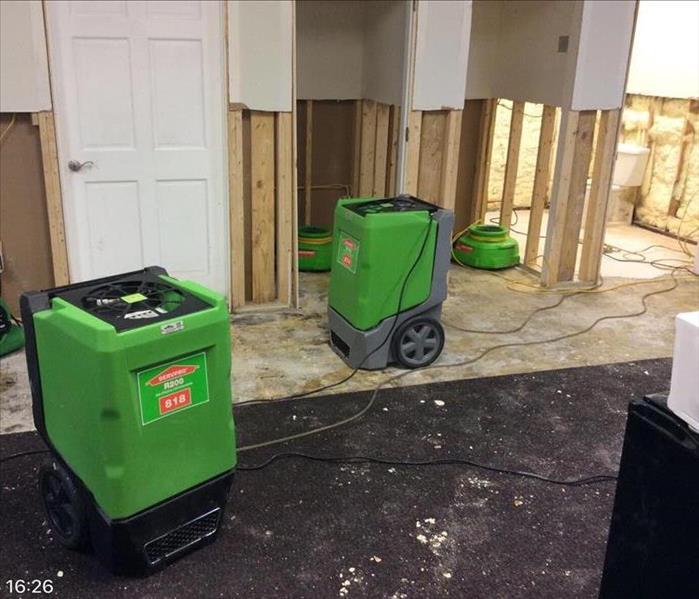Facts About Flood Insurance: Why you need to have it and what you need to know
1/15/2019 (Permalink)
According to the National Flood Insurance Program (NFIP), flooding is the most common natural disaster in the United States, affecting every single state. While hurricanes are mostly responsible for massive flooding catastrophes, other causes of flooding include snowmelt, heavy rain, dams or levees breaking, and new developments impacting water flow. In the past couple of years, many homes that are not in high-risk flood zones throughout the cities of Covington, Bogalusa, Franklinton, Denham Springs, and Baton Rouge experienced flooding simply because of heavy rainfall. In case you didn’t know, your homeowner’s policy will not cover damages caused by flooding. Purchasing a flood insurance policy is a wise idea even if your home is not located on the lakefront in Mandeville or near the river in downtown Covington. Just one inch of floodwater in your home can cost thousands of dollars in damages. Floodwater is contaminated and according to professional cleaning standards every material affected by flood water must be removed and discarded.
Picture a few inches of floodwater inside of your home. Imagine needing to replace your flooring, sheetrock, cabinets, furniture, clothes, electronics, etc. How much do you think this would cost? Purchasing a flood insurance policy will save you time and money, helping you and your family recover faster.
Below are a few facts about flood insurance and helpful tips to make you a more informed insured.
When should you purchase a flood insurance policy?
Do not wait for hurricane season to purchase a flood insurance policy. The average flood insurance policy takes 30 days to become active. However, according to the Federal Emergency Management Agency, a policy may go into effect sooner:
- “If your building is newly designated in a high-risk Special Flood Hazard Area, and you buy flood insurance within the 13-month period following a map revision: One-day waiting period.
- If you buy flood insurance in connection with making, increasing, extending, or renewing your mortgage loan: No waiting period.
- If you select additional insurance as an option on your flood insurance policy renewal bill: No waiting period.
- If your property is affected by flooding on burned federal land, and the policy is purchased within 60 days of the fire-containment: Possible waiver of the waiting period.”
But, for the most part, damages from flooding will only be covered after the thirty-day wait period. Now is always the best time to purchase a flood insurance policy.
What is covered by flood insurance?
Flood insurance is available to homeowners, business owners, and renters. For homeowners, your flood insurance policy will offer up to $250,000 for repairing the home itself and offer up to $100,000 for replacing personal items and your contents. Business owner policies will offer up to $500,000 for building repairs and $500,000 in building contents. Renters can purchase policies covering up to $100,000 of personal contents.
According to FEMA:
“Building coverage includes:
- The insured building and its foundation
- The electrical and plumbing system
- Central air conditioning equipment, furnaces, and water heaters
- Refrigerators, cooking stoves, and built-in appliances such as dishwashers
- Permanently installed carpeting over unfinished flooring
Contents coverage includes:
- Clothing, curtains, furniture and electronic equipment
- Portable items such as window air conditioners, microwaves, and dishwashers
- Carpeting that is not already included in property coverage
Policy prices will differ based upon deductible, the extent of coverages, flood risk, year of building construction, and other factors. The flood insurance market is evolving. Private insurance companies are beginning to offer flood insurance policies now. Speak with your insurance agent to see if you could benefit from purchasing a private flood insurance policy.
How do you purchase a flood insurance policy?
Speak with your insurance agent to learn more about the National Flood Insurance Program and private insurance policies. They should help you understand which options are best suited for your home and/or business. If your agent does not sell flood insurance, contact the NFIP Referral Call Center at 800-427-4661 for a referral.
What to do after a flood?
If your home or business has been damaged by floodwaters, then please do not enter the property until it is safe to do so. Once you can access your property again, start with contacting your insurance company to file a claim. Then, you can begin to inventory damaged items. Take photographs of everything. Write down each item’s purchase date and estimated value. This home inventory list will need to be submitted to your adjuster. Also, remember to take notes of your conversations with your insurance company and the adjuster. Jot down the date and time of each interaction, as well as specific notes about what was discussed.
If you do not have a flood insurance policy and your home or business has been damaged due to flooding, then you will be financially responsible for necessary repairs and restoration services. Only if a flooding incident has been declared a national disaster by the president will FEMA assistance become available. This assistance is usually in the form of a grant or low-interest disaster loan that you are required to repay.
The recovery process following flooding disasters is long and can be stressful. SERVPRO of Greater Covington and Mandeville understands the worry you will feel after your home has incurred damages. As your neighbors and your friends, we offer our expertise, guidance, and 24-hour emergency restoration services for those in need of disaster recovery. For questions or to receive assistance please contact our office by dialing 985-871-5375.
For more information about the National Flood Insurance Program or what to do before, during, or after a flood you can visit:
https://www.floodsmart.gov/how/what-to-know-before-buying-a-flood-insurance-policy
https://www.iii.org/article/facts-about-flood-insurance
https://www.fema.gov/disaster/4310-4313/updates/facts-and-myths-about-flood-insurance






 24/7 Emergency Service
24/7 Emergency Service
